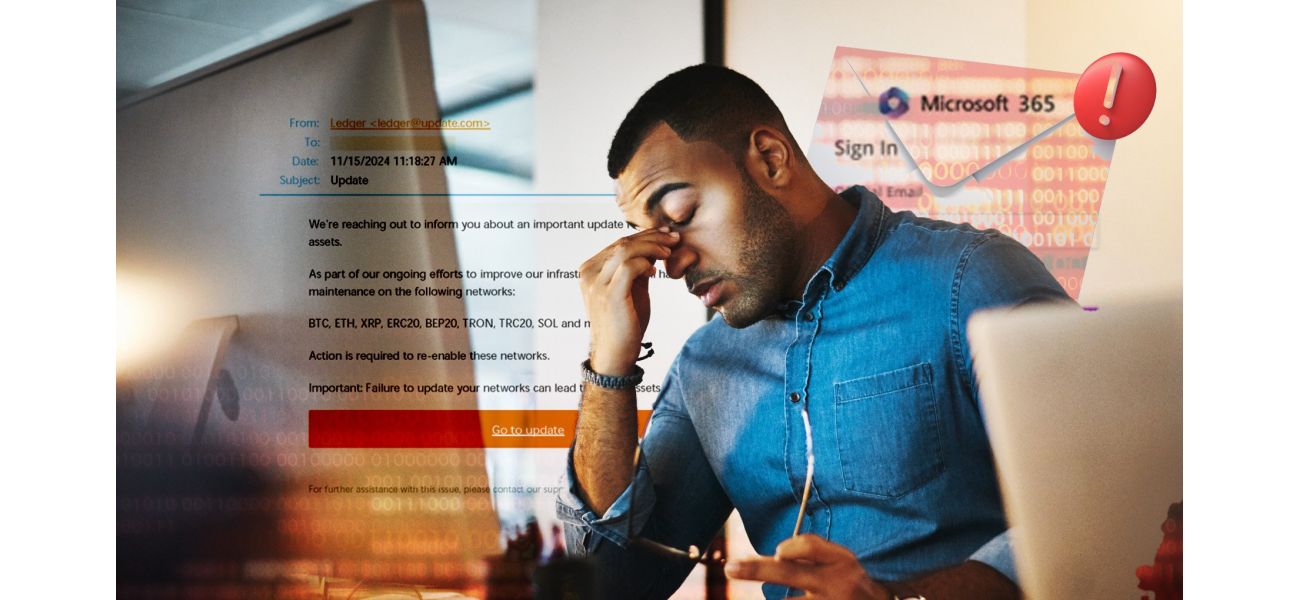2025: Be on the lookout for these four common email threats.
Someone has sent you a fraudulent email.
December 12th 2024.

In today's digital age, staying vigilant is crucial. We are already bombarded with a never-ending stream of emails, but now we have to be on the lookout for scammers trying to trick us into handing over our personal information. It's the last thing anyone needs right now.
At first glance, these scam emails may seem like any other message that shows up in your inbox. But don't be fooled, they often come from cybercriminals pretending to be someone else in order to deceive us into giving away sensitive data like passwords or credit card numbers. This tactic is known as "phishing."
Last year, the Suspicious Email Reporting Service received over 11 million reports of phishing attempts, a significant increase from the previous year. It's clear that phishing is not going away anytime soon, which is why a cybersecurity firm has identified the most widespread email threats to watch out for in 2025.
One of these threats is known as "file-sharing phishing," where scammers pose as popular file-hosting or e-signature services like Dropbox or Docusign. They send emails with suspicious links, often with enticing subject lines like "staff and payroll update." Once clicked, these links lead to fake websites where victims are asked to enter their login information, which is then stolen by the cybercriminals.
Another tactic is the use of AI-generated emails, which are becoming increasingly difficult to spot as technology advances. These emails can mimic the writing style of a specific person, making them more convincing and harder to detect. There are two forms of these robotic emails: Business email compromise and vendor email compromise. In the first, scammers use AI to impersonate someone's boss or colleague, while in the second, they pretend to be suppliers. In some cases, they may even take control of someone's actual email account and use it to send fraudulent messages to their contacts.
Cryptocurrency fraud is also on the rise, with scammers posing as companies that offer crypto storage solutions. They may send emails claiming that there is a problem with the victim's account and that they need to click a link to update their information. Once clicked, the link leads to a fake page where the victim is asked to enter their recovery phrase, which is then stolen by the scammer.
So how can we protect ourselves from falling for these scams? First and foremost, if an email seems suspicious, it's always best to contact the organization directly using the contact information on their official website. Never use the number or web address provided in the email. It's also important to report any suspicious emails to the authorities, even if you're not entirely sure it's a scam.
If you receive a suspicious text message or call, you can report it for free by forwarding it to 7726. Your provider can then block the sender and prevent others from falling victim to the scam. And if you do end up falling for a phishing scam and providing financial information, it's crucial to notify your bank immediately and report it to the proper authorities.
In summary, staying vigilant and being cautious when it comes to emails and other digital communication is crucial in today's world. By following these precautions and reporting any suspicious activity, we can help protect ourselves and others from falling victim to these scams. Let's stay alert and stay safe.
At first glance, these scam emails may seem like any other message that shows up in your inbox. But don't be fooled, they often come from cybercriminals pretending to be someone else in order to deceive us into giving away sensitive data like passwords or credit card numbers. This tactic is known as "phishing."
Last year, the Suspicious Email Reporting Service received over 11 million reports of phishing attempts, a significant increase from the previous year. It's clear that phishing is not going away anytime soon, which is why a cybersecurity firm has identified the most widespread email threats to watch out for in 2025.
One of these threats is known as "file-sharing phishing," where scammers pose as popular file-hosting or e-signature services like Dropbox or Docusign. They send emails with suspicious links, often with enticing subject lines like "staff and payroll update." Once clicked, these links lead to fake websites where victims are asked to enter their login information, which is then stolen by the cybercriminals.
Another tactic is the use of AI-generated emails, which are becoming increasingly difficult to spot as technology advances. These emails can mimic the writing style of a specific person, making them more convincing and harder to detect. There are two forms of these robotic emails: Business email compromise and vendor email compromise. In the first, scammers use AI to impersonate someone's boss or colleague, while in the second, they pretend to be suppliers. In some cases, they may even take control of someone's actual email account and use it to send fraudulent messages to their contacts.
Cryptocurrency fraud is also on the rise, with scammers posing as companies that offer crypto storage solutions. They may send emails claiming that there is a problem with the victim's account and that they need to click a link to update their information. Once clicked, the link leads to a fake page where the victim is asked to enter their recovery phrase, which is then stolen by the scammer.
So how can we protect ourselves from falling for these scams? First and foremost, if an email seems suspicious, it's always best to contact the organization directly using the contact information on their official website. Never use the number or web address provided in the email. It's also important to report any suspicious emails to the authorities, even if you're not entirely sure it's a scam.
If you receive a suspicious text message or call, you can report it for free by forwarding it to 7726. Your provider can then block the sender and prevent others from falling victim to the scam. And if you do end up falling for a phishing scam and providing financial information, it's crucial to notify your bank immediately and report it to the proper authorities.
In summary, staying vigilant and being cautious when it comes to emails and other digital communication is crucial in today's world. By following these precautions and reporting any suspicious activity, we can help protect ourselves and others from falling victim to these scams. Let's stay alert and stay safe.
[This article has been trending online recently and has been generated with AI. Your feed is customized.]
[Generative AI is experimental.]
0
0
Submit Comment





